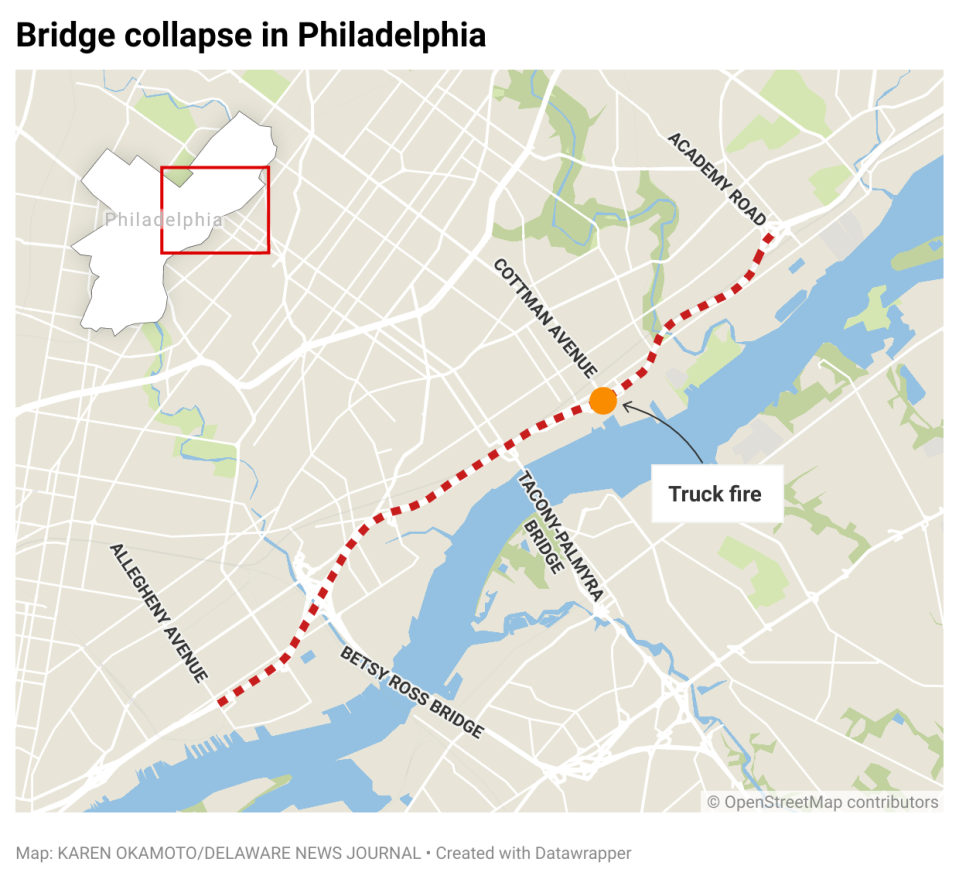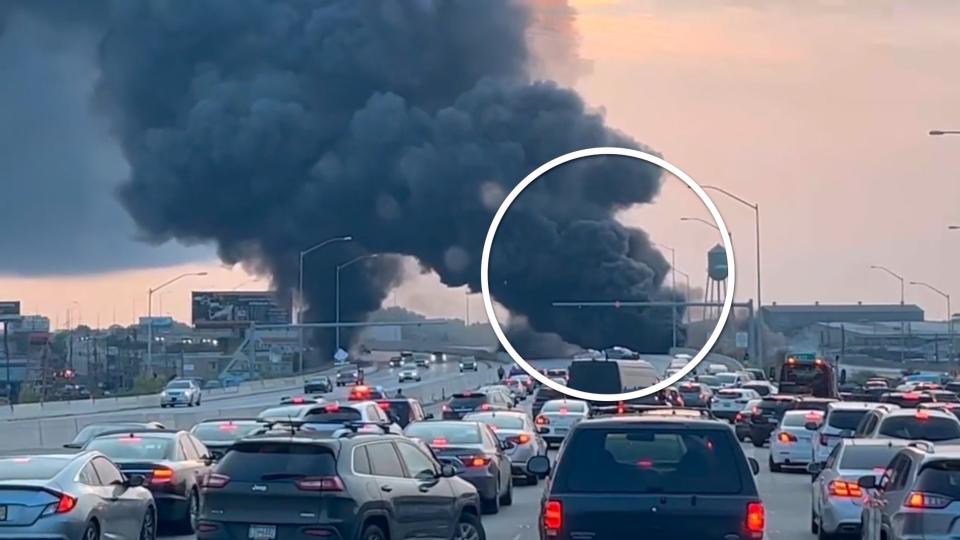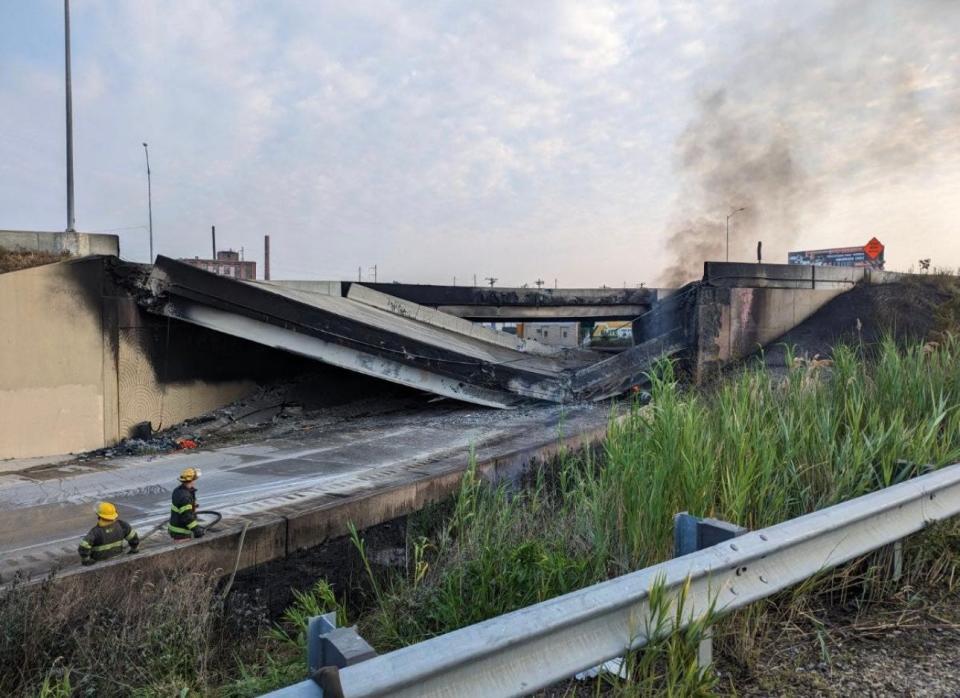Will your drive be impacted by the I-95 collapse in Philadelphia? Use these tips to cope
After a weekend commercial tanker fire beneath an I-95 overpass in Philly closed a stretch of highway in both directions, drivers are beginning their work weeks with a major headache as they consider how to navigate commutes and other travel.
The vehicle — a commercial tanker — was reportedly carrying 8,500 gallons of gasoline when it caught fire, according to the U.S. Coast Guard, and brought down an entire section of northbound lanes Sunday morning, said Pennsylvania Gov. Josh Shapiro.
The fire was out by 5 p.m., but a stretch of the interstate in both directions and many exits remain closed. Officials have said repairs may take many months.
I-95 bridge collapse: Where is Interstate 95 closed in Philadelphia? I-95 collapse map and what exits are closed
Philly detour: Highway collapse will cripple your commute. What that I-95 accident means for you
Envisioning the collapse site: Where is the I-95 collapse? Maps show where it happened and how traffic is affected

Federal transportation records show the stretch of I-95 typically carries 160,000 vehicles a day on average and is a main route for traveling north-to-south along the East Coast.
The incident is shaping up to warrant costly and time-consuming repairs, leaving local motorists to rethink their commutes and anticipate major obstacles while the impacted roadway is out of commission.
What should drivers in the area do to navigate the roads around I-95 collapse?

The impact of I-95 collapse goes beyond commuters and will impact drivers in nearby regions as motorists take detours into nearby arteries, causing traffic backups in Pennsylvania and New Jersey suburbs, said Jana Tidwell, manager of public and government affairs for AAA Mid-Atlantic.
There’s no estimate about how much extra time drivers should plan for, as this is dependent upon factors including time of day, weather, day of the week and local events, but motorists should anticipate lengthy delays now that Gov. Shapiro announced a months-long effort to rebuild the roadway, said Tidwell.
With that in mind, drivers can consider these tips from AAA Mid-Atlantic to navigate roadways during this challenging time:
Have a commuting plan. Adjust your schedule, take advantage of remote/hybrid work and map out alternate routes accordingly to steer clear of high-traffic areas and potential delays.
Seek alternate routes. Local transportation entities have issued alternate routes for I-95 commutes, traveling through states, etc. Drivers can also use a GPS or other mapping applications to help them navigate.
Consider using public transportation if applicable. SEPTA has added more trains and staff to the area and New Jersey residents can take advantage of NJ Transit or PATCO.
Prepare for your drive. Road delays will not only cost drivers more time, but also more money as additional gas expenses and tolls add up over time. For good measure, it’s worth filling up your tanks more than you anticipate, ensuring you are equipped to be stuck in traffic or winding through detours.
Keep tabs on restoration efforts. Check transportation websites and social media accounts for the latest news about I-95 repair work, public transportation changes, detours and more.
Stay calm and do not engage in aggressive driving behaviors. While having a longer travel time is no one’s cup of tea, remember that the other drivers around you are probably feeling frustrated too. Listen to your favorite album, keep some snacks and water stocked up, and keep the car cool to help you stay cool.
What detours should drivers use to avoid I-95 collapse?

Tidwell suggests that Pennsylvania motorists head into New Jersey and then back into the Keystone State to find the best roads to avoid I-95 hassle.
The Pennsylvania Department of Transportation (PennDOT) has announced several detour routes to help local traffic get around the I-95 collapse.
The detours are as follows:
I-95 north: I-676 west to I-76 west, take Exit 304B for U.S. 1 north to Route 63 east (Woodhaven Road) and head east, which goes around I-95 north of the collapse.
I-95 south: Route 63 West (Woodhaven Road), U.S. 1 south to I-76 east, then get on Route 676 east and merge into I-95 south.
Local detour routes include:
I-95 north: Exit 26 (Betsy Ross/Aramingo Ave.), Tacony Street, New State Road, Milnor Street, Bleigh Avenue and Linden Avenue to access I-95 north.
I-95 south: Cottman Avenue exit, Bleigh Avenue and State Road to access I-95 south at Longshore Ave.
According to PennDot, a stretch of highway is still closed in both directions, but more of I-95 southbound opened up around 9 p.m. on Sunday night.
I-95 southbound is currently closed at Exit 30, and reopens where State Road merges with the highway near Longshore Ave. I-95 northbound remains closed at Exit 23 and reopens past the collapse site around Exit 32.
Got a tip or a story idea? Contact Krys'tal Griffin at kgriffin@delawareonline.com.
This article originally appeared on Delaware News Journal: Tips to navigate Philadelphia I-95 bridge collapse, detours, delays

